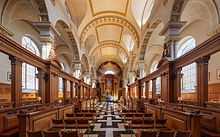St Bride's, Fleet Street
| St. Bride's Church | |
|---|---|

St Bride's Church, as viewed from the nave looking east towards the altar.
|
|
| Location | Fleet Street, City of London |
| Country | United Kingdom |
| Denomination | Church of England |
| Website | http://www.stbrides.com |
| Architecture | |
| Heritage designation | Grade I listed building |
| Architect(s) | Sir Christopher Wren |
| Style | Baroque |
| Administration | |
| Diocese | London |
| Clergy | |
| Rector | Canon Dr Alison Joyce |
St Bride's Church is a church in the City of London, England. The building's most recent incarnation was designed by Sir Christopher Wren in 1672 in Fleet Street in the City of London, though Wren's original building was largely gutted by fire during the London Blitz in 1940. Due to its location in Fleet Street, it has a long association with journalists and newspapers. The church is a distinctive sight on London's skyline and is clearly visible from a number of locations. Standing 226 feet (69m) high, it is the second tallest of all Wren's churches, with only St Paul's itself having a higher pinnacle.
St. Bride's may be one of the most ancient churches in London, with worship perhaps dating back to the conversion of the Middle Saxons in the 7th century. It has been conjectured that, as the patron saint is St Bridget of Ireland, it may have been founded by Celtic monks, missionaries proselytising the English.
The present St Bride's is at least the seventh church to have stood on the site. Traditionally, it was founded by St Bridget in the sixth century. Whether or not she founded it personally, the remnants of the first church appear to have significant similarities to a church of the same date in Kildare, Ireland. The Norman church, built in the 11th century, was of both religious and secular significance; in 1210, King John held a parliament there. It was replaced by a larger church in the 15th century,
St Bride's association with the newspaper business began in 1500, when Wynkyn de Worde set up a printing press next door. Until 1695, London was the only city in England where printing was permitted by law.
...
Wikipedia
